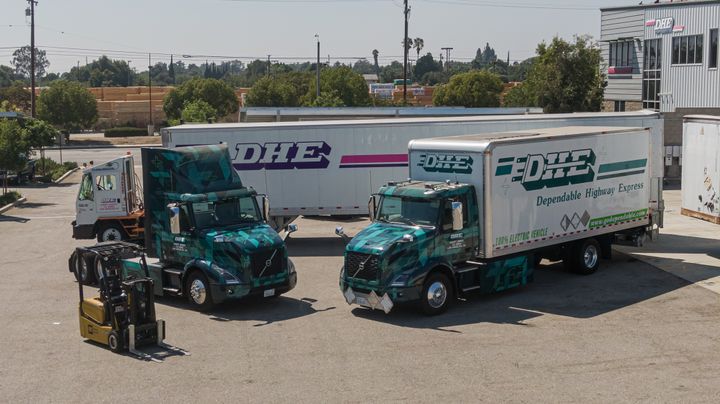Photo: Volvo Trucks North America
Dependable Highway Express has turned to Volvo LIGHTS to electrify its Southern California fleet operations.
Southern California carrier Dependable Highway Express has been piloting two Volvo electric trucks as part of its sustainability efforts and plans to order more. The company recently completed several major electrification initiatives to further reduce the climate and air quality impacts of its Southern California freight operations, including adding Volvo electric trucks to its fleet.
Through the Volvo LIGHTS project, DHE introduced Volvo VNR Electric Class 8 trucks, battery-electric yard trucks and forklifts, charging infrastructure for fleet vehicles and employees’ personal vehicles, as well as solar panels and onsite energy storage at its shipping and receiving facility in Ontario, California.
DHE has signed a letter of commitment to purchase an additional 10 Volvo VNR Electric trucks in 2022, Volvo announced.
“DHE is a prime example of a fleet leading the path towards sustainable freight movement,” said Peter Voorhoeve, president, Volvo Trucks North America, in a news release. “DHE’s partnership has been critical to the success of the Volvo LIGHTS project over the past two years. We are proud that DHE is planning to deploy additional VNR Electric trucks in the very near future — a true testament to moving electromobility and sustainable transport solutions forward in the trucking industry.”
Introduced two years ago, the Volvo LIGHTS project is a collaboration between Volvo Trucks, the South Coast Air Quality Management District (South Coast AQMD) and 13 other organizations to develop a blueprint to successfully introduce battery-electric trucks and equipment into the market at scale.
This past September, DHE began piloting two Volvo VNR Electric heavy-duty trucks out of its Ontario facility. Operating between 60 and 80 miles daily, the vehicles continue to transport goods between warehouse facilities throughout Southern California. As part of the Volvo LIGHTS project, the VNR Electric trucks run various routes while collecting data on the vehicles’ performance under differing road and real-world operating conditions.
“By deploying the Volvo VNR Electric trucks and other zero-emission equipment, we can reduce our maintenance and fuel costs, while providing a quiet, clean, comfortable working environment for our drivers and employees,” said Joe Finney, chief operating officer, DHE, in the news release. “We have made measurable progress towards achieving our own sustainability goals, while taking one more step towards a sustainable goods movement industry.”
To install and maintain the charging infrastructure needed to support the electric trucks and equipment, DHE worked closely with Volvo Trucks North America, Southern California Edison, Greenlots, ABB, Core States and the City of Ontario in order to upgrade the facility’s power supply and install two 150-kW chargers. The chargers will use Greenlots’ Sky EV network charging software to effectively balance the electricity demand from the trucks, equipment, existing facilities, and the electricity grid.
Through the Volvo LIGHTS project, DHE also has replaced 100% of the freight equipment used in its Ontario shipping and receiving facility with battery-electric models. DHE currently operates 14 Yale Electric forklifts supported by eight Level 2 (L2) forklift chargers, and two Orange EV yard tractors supported by an additional two L2 chargers.
To further mitigate grid impacts and energy costs, DHE worked with Solar Optimum, a solar installation company, to install more than 2,300 solar panels on the roof of its Ontario facility and employee parking canopies. Annually, the solar panels will generate 1.291 GWh of renewable electricity.
See DHE’s Ontario facility in action and hear first impressions about the Volvo VNR Electric from real drivers:
By Ronnie Wendt
CUT COTS OF THE FLEET WITH OUR AUDIT PROGRAM
The audit is a key tool to know the overall status and provide the analysis, the assessment, the advice, the suggestions and the actions to take in order to cut costs and increase the efficiency and efficacy of the fleet. We propose the following fleet management audit.




